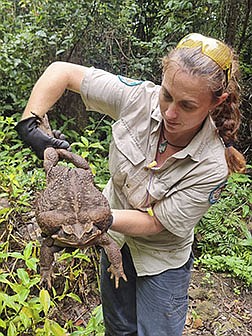Australian officials are trying to determine whether a cane toad they call "Toadzilla" could be the largest of its species.
Kylee Gray, a ranger at Conway National Park in Queensland, Australia, stopped her vehicle this month in a wild rainforest after she saw a snake slithering across the track. But what she saw next was no snake -- or, for that matter, anything she had seen before.
When she picked up the creature, she was holding a monster cane toad that she believes could be the largest of its kind in the world. This was the first time Gray met the large, poisonous amphibian she'd soon be calling "Toadzilla."
"I reached down and grabbed the cane toad and couldn't believe how big and heavy it was," she said in a statement issued by the Queensland Department of Environment and Science.
When rangers returned to base Jan. 12, they weighed Toadzilla at 5.95 pounds, which could be a world record. They concluded that the toad is a female since they weigh more than their male counterparts, Gray said.
She considered naming the toad "Connie." But upon further consideration, Gray said, she thought that instead of a Connie, the cane toad looked more like a "Godzilla," the fictional monster that wreaks havoc on Japan.
"We dubbed it Toadzilla and quickly put it into a container so we could remove it from the wild," Gray said.
The heaviest toad on record was measured in March 1991 when Prinsen, a pet cane toad in Sweden, weighed in at 5.13 pounds and measured at 1 foot, 9 inches when fully extended, according to Guinness World Records.
While Toadzilla's age is unclear, cane toads can live for up to 15 years in the wild, which made park officials think that "this one has been around for a long time."
"She has created a lot of interest among our ranger staff due to her size," Gray said in a statement.
Native to South America and mainland Central America, the cane toad was introduced into Queensland in 1935 to help control the cane beetle population. However, in the decades since it was introduced, the amphibian has not only failed to control the insects but also has become one of the worst invasive species in the world.
Cane toads, which have an average weight of almost three pounds, have been "remarkably successful in reproducing and spreading themselves," according to National Geographic.
The species is estimated now to number in the millions in Australia, with a range of thousands of square miles in the northeastern part of the country, according to research by the University of Western Australia.
The cane toad's diet consists mainly of insects, but it will eat just about anything, including reptiles, birds and even small mammals.
"They are opportunists," the Queensland Department of Environment and Science said in a news release about Toadzilla.
The warty amphibian can secrete a milky poison from the parotid glands behind its shoulders that can be fatal to wildlife. Cane toads are also particularly dangerous to dogs that bite the amphibian and ingest the toxin.
"Eating a cane toad will result in the toxin absorbing much quicker than just licking, so if your dog has bitten or consumed a cane toad, it is essential that you take them to a vet immediately," according to Greencross Vets in Australia.
Even with the excitement and curiosity surrounding the huge cane toad, the Queensland Department of Environment and Science announced on Twitter that Toadzilla was "euthanized due to the environmental damage they cause." Toadzilla has now been taken to the Queensland Museum for further analysis on whether she is indeed the world's largest recorded cane toad.
"We're pleased to have removed her from the national park," Gray said.

